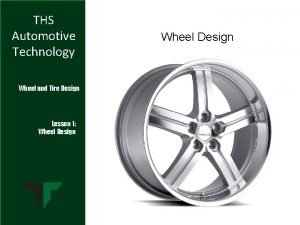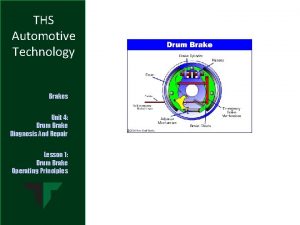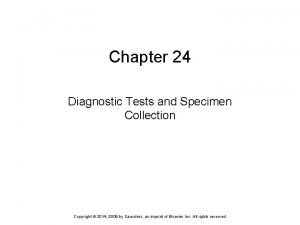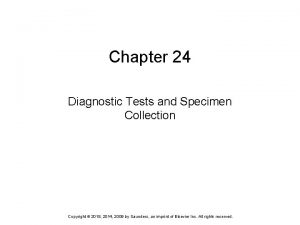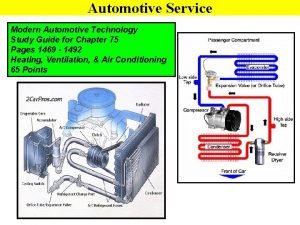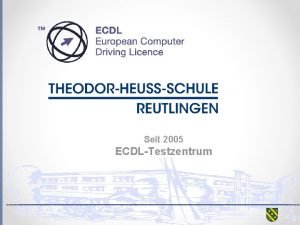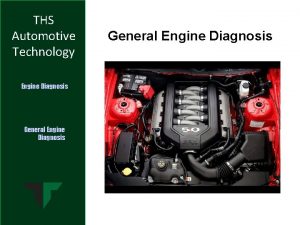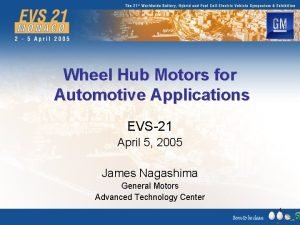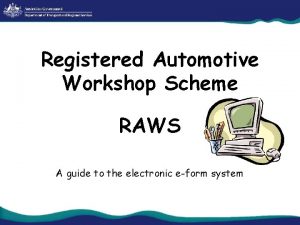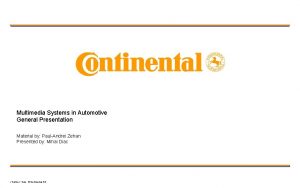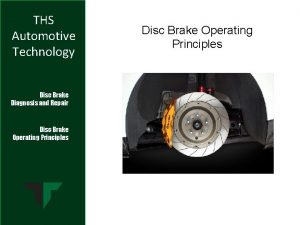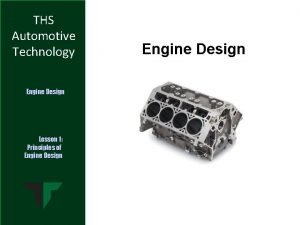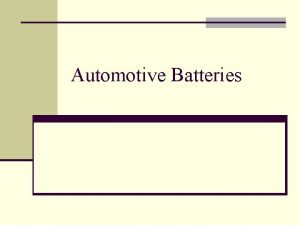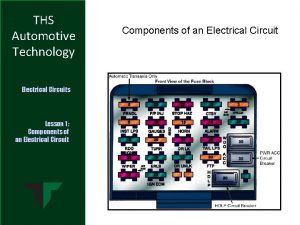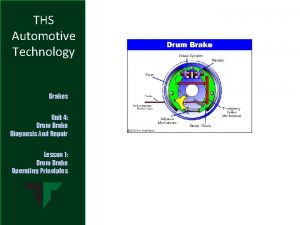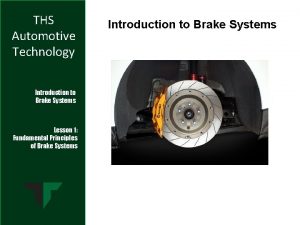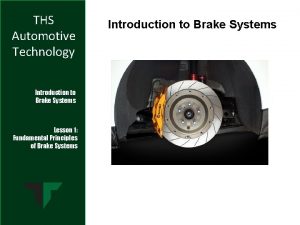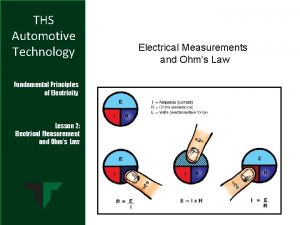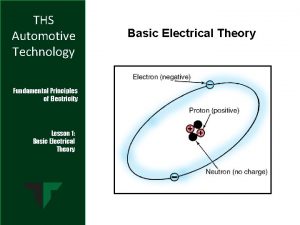THS Automotive Technology Engine Diagnosis Engine Diagnostic Tests


































- Slides: 34

THS Automotive Technology Engine Diagnosis Engine Diagnostic Tests

THS Automotive Technology Engine Diagnosis Engine Diagnostic Tests Engine diagnostic tests NOTE: Testing the engine’s mechanical condition is required when the cause of a problem is not located during the preliminary inspection. The common testing procedures are those for engine vacuum, cylinder power balance, cylinder compression, cylinder leakage, oil pressure, and cooling system operation. (Refer to Unit 5 for the latter two tests. ) These tests are designed to locate internal engine problems before disassembling the engine.

THS Automotive Technology Engine Diagnosis Engine Diagnostic Tests Procedures for performing engine vacuum tests • Perform a vacuum gauge test to determine engine condition and performance. NOTE: Accurately diagnosing problems with a vacuum gauge can be difficult. Study and compare readings to diagnostic charts. Connect the vacuum gauge to an intake manifold vacuum source. Connect a vacuum hose to an accessible intake manifold vacuum connector and extend it up to the vacuum gauge. Connect the exhaust ventilation equipment. CAUTION: Be sure to use approved exhaust ventilation equipment when operating a vehicle in an enclosed area. Start the engine and allow it to reach normal operating temperature.

THS Automotive Technology Procedures for performing engine vacuum tests Observe and record the reading with the engine at idle speed. Normal idle vacuum is approximately between 18 in and 21 in. A low reading or an erratic vacuum gauge needle indicates a problem. Engine Diagnosis Engine Diagnostic Tests Shut off the engine. Disconnect the test equipment. Disconnect the exhaust ventilation equipment.

THS Automotive Technology Engine Diagnosis Engine Diagnostic Tests Procedures for performing engine vacuum tests • Perform an exhaust restriction test to determine if the exhaust system is restricted or has excessive back pressure. Connect the vacuum gauge to an intake manifold vacuum source. Connect a vacuum hose to an accessible intake manifold vacuum connector and extend it up to the vacuum gauge. Connect a tachometer to the engine. Connect the exhaust ventilation equipment. CAUTION: Be sure to use approved exhaust ventilation equipment when operating a vehicle in an enclosed area. Start the engine. Gradually accelerate the engine rpm from idle to 2, 000 rpm. Observe and record the reading.

THS Automotive Technology Engine Diagnosis Procedures for performing engine vacuum tests Maintain the engine speed at 2, 000 rpm for about 10 seconds or longer. Observe and record the reading. The vacuum gauge should hold steady or increase slightly. The vacuum reading gradually decreases if the exhaust system is restricted. Shut off the engine. Disconnect the test equipment. Disconnect the exhaust ventilation equipment. Engine Diagnostic Tests • Perform a cranking vacuum test to determine if the engine is mechanically sound. Connect the exhaust ventilation equipment. CAUTION: Be sure to use approved exhaust ventilation equipment when operating a vehicle in an enclosed area. Start the engine and allow it to reach normal operating temperature. Shut off the engine.

THS Automotive Technology Procedures for performing engine vacuum tests Connect a vacuum gauge to a nonported vacuum source on the intake manifold. Disable the ignition system. Engine Diagnosis Engine Diagnostic Tests Completely block the throttle valve so that air cannot enter. Crank the engine. Observe and record the cranking vacuum. Disconnect the vacuum gauge. Unblock the throttle valve. Enable the ignition. Disconnect the exhaust ventilation equipment.

THS Automotive Technology Procedures for performing engine vacuum tests The following are possible results for this test. • Satisfactory cranking vacuum indicates a mechanically sound engine. Engine Diagnosis Engine Diagnostic Tests • Uneven or pulsating cranking vacuum indicates defective valves, defective piston rings, a defective head gasket, or an uneven cranking speed. • Below normal cranking vacuum indicates excessive resistance in the battery cables, a defective cranking motor, or excessive mechanical drag in the engine. • Uneven cranking vacuum indicates uneven compression or a defective starter. NOTE: If the cranking vacuum is uneven, perform a cranking engine cylinder compression test or a cylinder leakage test. Satisfactory engine performance cannot be obtained until existing compression or vacuum leaks are eliminated.

THS Automotive Technology Engine Diagnosis Engine Diagnostic Tests Procedures for performing engine vacuum tests • Based on the tests, determine the necessary action to correct any problems. Include further diagnosis and/or repairs.

THS Automotive Technology Engine Diagnosis Procedures for performing a cylinder power balance test • Perform a cylinder power balance test to determine if a cylinder is supporting its share of engine load. The purpose of the test is to compare the difference in the percentage of rpm drop. The variance between cylinders should not exceed 20%. Connect the cylinder balance tester to the engine according to manufacturer’s procedures. Engine Diagnostic Tests NOTE: This test may also be performed using an engine analyzer or scan tool. Connect a tachometer to the engine if it is not part of the cylinder balance tester. NOTE: The tachometer is necessary because the drop in engine rpm is viewed on the tachometer.

THS Automotive Technology Engine Diagnosis Procedures for performing a cylinder power balance test Connect the exhaust ventilation equipment. CAUTION: Be sure to use approved exhaust ventilation equipment when operating a vehicle in an enclosed area. Start the engine and allow it to reach normal operating temperature. Shut off the engine. Engine Diagnostic Tests Disconnect the oxygen sensor and unplug the exhaust gas recirculation (EGR) hose or connector. Restart the engine. Bring the engine speed to 1, 000 rpm and maintain that speed. Select the cylinder shorting mode on the cylinder balance tester. Disable the idle air control on a fuel-injected engine, which is necessary because it compensates for the shorted cylinder and raises the engine rpm.

THS Automotive Technology Engine Diagnosis Engine Diagnostic Tests Procedures for performing a cylinder power balance test Short each cylinder for the same amount of time, about 2 seconds to 3 seconds. Give the engine about 5 seconds to stabilize between each short. NOTE: All shorted cylinders should cause the rpm to drop a certain percentage. Observe the tachometer for the amount of rpm drop on each cylinder. Compare the reading to the following specifications. • A four-cylinder engine should have a 10% to 18% drop in rpms. • A six-cylinder engine should have an 8% to 12% drop in rpms. • An eight-cylinder engine should have a 4% to 8% drop in rpms.

THS Automotive Technology Engine Diagnosis Procedures for performing a cylinder power balance test NOTE: All cylinders in the engine should drop about the same amount. NOTE: Check a cylinder that does not show rpm drop because this causes a cylinder to miss. Shut off the engine. Disconnect the test equipment. Disconnect the exhaust ventilation equipment. Engine Diagnostic Tests Reconnect the oxygen sensor and the EGR hose or connector. Clear the codes. Based on the tests, determine the necessary action to correct any problems. Include further diagnosis and/or repairs.

THS Automotive Technology Engine Diagnosis Procedures for performing engine cylinder compression tests • There are two types of engine cylinder compression tests. A cranking engine cylinder compression test accurately identifies leaking piston rings, leaking valves, or a blown head gasket. A running engine cylinder compression test determines volumetric efficiency. Engine Diagnostic Tests • Volumetric efficiency is the measure of the quantity of air brought into the cylinder during various engine operating conditions. It is proportional to the airflow that is limited by the quantity that can flow past the valves and into the combustion chamber. After a certain rpm, the amount of pressure in the combustion chamber starts to decrease. The amount of restriction causes reduced airflow and low compression. Volumetric efficiency is illustrated by cranking, idle, and snap acceleration compression.

THS Automotive Technology Engine Diagnosis Engine Diagnostic Tests Procedures for performing engine cylinder compression tests • Cranking compression The throttle is closed during cranking. The total airflow into the combustion chamber is limited by the quantity of air that can flow past the throttle plate and through the idle air bypass. The quantity of air entering the combustion chamber is 80% of the total capacity at wide open throttle. About 150 pounds per square inch (psi) of compression at wide open throttle can be expected. If the throttle plate is closed during cranking, a decrease in pressure should occur. If compression does not increase when the throttle opens during a cranking engine cylinder compression test, there is a restriction in the intake or exhaust airflow.

THS Automotive Technology Engine Diagnosis Engine Diagnostic Tests Procedures for performing engine cylinder compression tests • Idle compression When the engine idles, the throttle position closes, but the rpm is approximately three times faster than the cranking rpm. Because the total volume of the air/fuel mixture being drawn into the cylinder is less due to the throttle position and engine rpm, the idle compression is reduced to about 100 psi. The piston moves faster than the air because of the restriction caused by the closed throttle plate.

THS Automotive Technology Procedures for performing engine cylinder compression tests Characteristics of idle compression • The air is restricted by the throttle plate. Engine Diagnosis • The crankshaft speed is four to five times faster than the cranking speed. • There is less air entering the cylinder per engine cycle. Engine Diagnostic Tests • There is typically 50 psi to 60 psi, and the gauge must be “burped. ” • If the rpm increases slowly, the pressure decreases. • There are no manufacturer’s specifications to compare with other cylinders.

THS Automotive Technology Engine Diagnosis Procedures for performing engine cylinder compression tests • Snap acceleration compression By snap accelerating the throttle, the compression increases and the area for air movement increases about 80 times. The throttle opening allows more of the air/fuel mixture into the cylinder in the same short time. Engine Diagnostic Tests The increased compression with more fuel produces increased power and causes the rpm to increase, resulting in higher running compression pressure and more power.

THS Automotive Technology Engine Diagnosis Engine Diagnostic Tests Procedures for performing engine cylinder compression tests When the throttle quickly snaps open to remove throttle plate restriction, the readings increase to about 80% of cranking compression. • A high reading indicates an exhaust restriction that is most likely caused by an exhaust valve train problem. • A low reading indicates an intake restriction most likely caused by an intake valve train problem or a carboned valve. • There are differences between a cranking engine cylinder compression test and a running engine cylinder compression test. A cranking engine cylinder compression test isolates a cylinder seal problem, and a running engine cylinder compression test shows a volumetric efficiency problem.

THS Automotive Technology Engine Diagnosis Engine Diagnostic Tests Procedures for performing engine cylinder compression tests By snapping the throttle, the airflow into the engine dramatically increases and an increase in the compression pressure occurs. It is possible to compare the series of readings with the other cylinders to isolate the best candidate for a potential volumetric efficiency problem. • There are variables that affect a running engine cylinder compression test. The compression relationship on a running engine is about 60 psi at idle and about 40 psi when accelerating to 1, 500 rpm. The throttle position and engine rpm restrict the amount of air that can enter the cylinder when compared to idle rpm.

THS Automotive Technology Engine Diagnosis Engine Diagnostic Tests Procedures for performing engine cylinder compression tests With the engine running, the piston moves faster than the airflow into the cylinder through the small passage created by the closed throttle plate. Similar to a slow-crank condition, the cylinder is not as full of air as it can be. This results in the running compression being less than cranking compression. Because the piston moves much faster in running compression, the normal cylinder seal leakage and heat loss to the cylinder walls are reduced to almost nothing. The result is higher compression temperature and a spark that easily ignites the air/fuel mixture.

THS Automotive Technology Procedures for performing engine cylinder compression tests • Perform cranking engine cylinder compression tests. Perform a cranking engine cylinder compression test with the throttle closed. Engine Diagnosis Engine Diagnostic Tests • Connect the exhaust ventilation equipment. CAUTION: Be sure to use approved exhaust ventilation equipment when operating a vehicle in an enclosed area. • Start the engine and allow it to reach normal operating temperature. • Shut off the engine. • Disable the ignition and fuel systems. • Remove the air filter.

THS Automotive Technology Procedures for performing engine cylinder compression tests • Use compressed air to blow debris away from the spark plugs. Remove the spark plugs. • Install the compression gauge in one cylinder. Engine Diagnosis Engine Diagnostic Tests Removing the Spark Plugs and Installing the Compression Gauge

THS Automotive Technology Engine Diagnosis Procedures for performing engine cylinder compression tests • Crank the engine at least four compression strokes. If the engine cranks slowly, the readings are not accurate. Charge the battery. Then, test the battery, starting, and charging systems. It may be necessary to keep a battery charger on the battery to perform this test. • Observe the compression gauge. Record the readings of the first “puff” and at the highest point. Engine Diagnostic Tests • Repeat the procedure for each cylinder. • Remove the compression gauge. Reinstall the air filter and spark plugs. Enable the ignition and fuel systems. Disconnect the exhaust ventilation equipment.

THS Automotive Technology Procedures for performing engine cylinder compression tests Perform a cranking engine cylinder compression test with the throttle open. • Connect the exhaust ventilation equipment. Engine Diagnosis Engine Diagnostic Tests CAUTION: Be sure to use approved exhaust ventilation equipment when operating a vehicle in an enclosed area. • Start the engine and allow it to reach normal operating temperature. • Shut off the engine. • Disable the ignition and fuel systems. • Remove the air filter. • Block the throttle valve to the wide open position.

THS Automotive Technology Procedures for performing engine cylinder compression tests • Use compressed air to blow debris away from the spark plugs. Remove the spark plugs. • Install the compression gauge in one cylinder. Engine Diagnosis Engine Diagnostic Tests • Crank the engine at least four compression strokes. If the engine cranks slowly, the readings are not accurate. Charge the battery. Then, test the battery, starting, and charging systems. It may be necessary to keep a battery charger on the battery to perform this test. • Observe the compression gauge. Record the readings of the first “puff” and at the highest point. • Repeat the procedure for each cylinder. • Unblock the throttle valve.

THS Automotive Technology Engine Diagnosis Engine Diagnostic Tests Procedures for performing engine cylinder compression tests • Remove the compression gauge. Reinstall the air filter and spark plugs. Enable the ignition and fuel systems. Disconnect the exhaust ventilation equipment. Based on the tests, determine the necessary action to correct any problems. Include further diagnosis and/or repairs. • If the first “puff” is low but gradually builds up to a normal reading, there could be a worn ring or cylinder wall problem. • If the reading is higher than specifications or higher on one cylinder, there could be carbon buildup or a camshaft problem. • If the reading remains the same on some strokes or is slow on others or if different readings occur on subsequent tests of the same cylinder, there could be a sticking valve.

THS Automotive Technology Procedures for performing engine cylinder compression tests • Perform a running engine cylinder compression test. Connect the exhaust ventilation equipment. Engine Diagnosis Engine Diagnostic Tests CAUTION: Be sure to use approved exhaust ventilation equipment when operating a vehicle in an enclosed area. Start the engine and allow it to reach normal operating temperature. Shut off the engine. Use compressed air to blow debris away from the spark plugs. Remove one spark plug and connect a spark tester to the plug wire. Install the compression gauge in the cylinder. Start the engine and allow it to idle.

THS Automotive Technology Procedures for performing engine cylinder compression tests Release the compression gauge pressure. Observe and record the compression reading at idle. Engine Diagnosis Slowly raise the engine speed to 1, 500 rpm. Observe and record the compression reading. Return the engine speed to idle. Engine Diagnostic Tests Release the compression gauge pressure. Snap the throttle open and then closed. Observe and record the compression reading. NOTE: Attempt to open the throttle as wide as possible without increasing the engine speed because this allows more air in without increasing the rpm.

THS Automotive Technology Procedures for performing engine cylinder compression tests Repeat the procedure for each cylinder. Compare the readings to the following specifications. • Compression at idle should be 100 psi (+/-20). Engine Diagnosis Engine Diagnostic Tests • Compression at 1500 rpm should be 60 psi (+/-20). • Compression when snapping the throttle open and closed should be 80% of wide open throttle cranking compression. Shut off the engine. Remove the compression gauge. Remove the spark tester and reinstall the spark plug. Disconnect the exhaust ventilation equipment. Based on the tests, determine the necessary action to correct any problems. Include further diagnosis and/or repairs.

THS Automotive Technology Engine Diagnosis Procedures for performing a cylinder leakage test • Perform a cylinder leakage test to determine the amount of compression loss in a cylinder and pinpoint the source of compression leakage. Connect the exhaust ventilation equipment. CAUTION: Be sure to use approved exhaust ventilation equipment when operating a vehicle in an enclosed area. Engine Diagnostic Tests Start the engine and allow it to reach normal operating temperature. Shut off the engine. Remove the air filter. Block the throttle valve to the wide-open position. Use compressed air to blow debris away from the spark plugs. Remove the spark plugs.

THS Automotive Technology Procedures for performing a cylinder leakage test Remove the crankcase filler cap. Check the coolant level. If necessary, refill the radiator. Engine Diagnosis Rotate the engine until the cylinder is at top dead center (TDC). Calibrate and connect the cylinder leakage tester according to manufacturer's procedures. Engine Diagnostic Tests Observe and record the reading. Repeat the procedure for each cylinder. Compare the readings to the following specifications. • If engine condition is excellent, leakage is 0% to 4%. • If engine condition is good, leakage is 5% to 9%. • If engine condition is fair, leakage is 10% to 14%. • If engine condition is poor, leakage is 15% to 20%.

THS Automotive Technology Engine Diagnosis Engine Diagnostic Tests Procedures for performing a cylinder leakage test If there is excessive cylinder leakage, listen at the different points to determine the source of the leak. Location to Listen or Look for Air Leak Problem Component Exhaust tailpipe Exhaust valve Throttle valve Intake valve Oil filler cap or positive crankcase ventilation valve connection Piston rings Spark plug hole of each cylinder Head gasket Air bubbles in radiator Cylinder head or block (may be cracked) Head gasket (leaking into cooling system)

THS Automotive Technology Procedures for performing a cylinder leakage test Disconnect the cylinder leakage tester. Unblock the throttle valve. Engine Diagnosis Reinstall the air filter and spark plugs. Replace the crankcase filler cap. Disconnect the exhaust ventilation equipment. Engine Diagnostic Tests Based on the tests, determine the necessary action to correct any problems. Include further diagnosis and/or repairs.
 Ths automotive
Ths automotive Ths automotive
Ths automotive Tire and wheel design
Tire and wheel design Non servo drum brakes
Non servo drum brakes Automotive technology principles diagnosis and service
Automotive technology principles diagnosis and service Chapter 24 diagnostic tests and specimen collection
Chapter 24 diagnostic tests and specimen collection Chapter 24 diagnostic tests and specimen collection
Chapter 24 diagnostic tests and specimen collection Ace different tests help iq still
Ace different tests help iq still Modern automotive technology answer key
Modern automotive technology answer key China automotive technology & research center
China automotive technology & research center Automotive technology sixth edition
Automotive technology sixth edition Automotive technology chapter 51 answers
Automotive technology chapter 51 answers Mechanical technology automotive grade 11
Mechanical technology automotive grade 11 Center for advanced automotive technology
Center for advanced automotive technology Rivet split pin dublin
Rivet split pin dublin Dependent nursing interventions
Dependent nursing interventions Medical diagnosis and nursing diagnosis difference
Medical diagnosis and nursing diagnosis difference Second phase of nursing process
Second phase of nursing process Types of nursing diagnoses
Types of nursing diagnoses Perbedaan diagnosis gizi dan diagnosis medis
Perbedaan diagnosis gizi dan diagnosis medis Ths-ldk
Ths-ldk If u cn rd ths u cn gt a gd jb w hi pa!
If u cn rd ths u cn gt a gd jb w hi pa! 100 ths
100 ths If u cn rd ths u cn gt a gd jb w hi pa
If u cn rd ths u cn gt a gd jb w hi pa Certyfikat ecdl
Certyfikat ecdl General engine diagnosis
General engine diagnosis External and internal combustion engine
External and internal combustion engine Slatten racing engines
Slatten racing engines Wheel hub motors for automotive applications
Wheel hub motors for automotive applications Dristas utm
Dristas utm Sap s4 hana automotive
Sap s4 hana automotive Registered automotive workshop
Registered automotive workshop True automotive
True automotive V cycle automotive
V cycle automotive Automotive aftermarket solutions
Automotive aftermarket solutions


